Book Review: “Legacy in Stone: Syria before War” by Kevin Bubriski
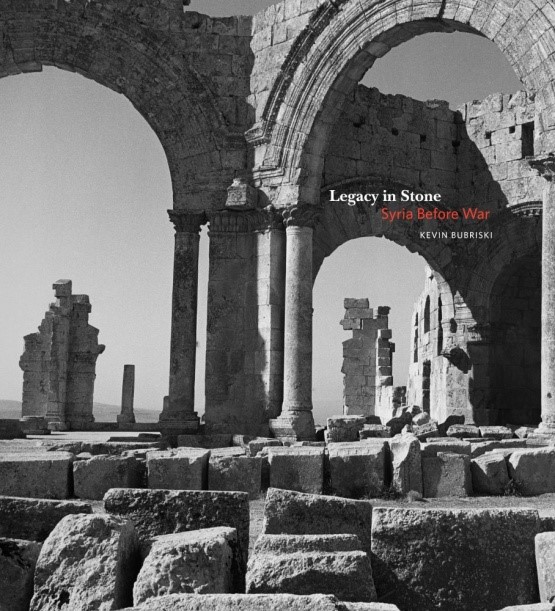
Cover: Church of St Simeon, Northwestern part of Aleppo, Syria, 2003: Kevin Bubriski, “Legacy in Stone: Syria before War”, powerHouse Books, New York 2019 ©
My two visits to St. Simeon, once in the rain and another day in sunshine, let me see the moods of the architecture and its rich spiritual resonance, an echo of the multitudes of pilgrims and practitioners who visited and inhabited this sacred space.
(Kevin Bubriski, Legacy in Stone, p. 161)
Last autumn, a friend sent me a link coupled with a question: Have you seen this? The link and her question referred to “Legacy in Stone: Syria before War” by Kevin Bubriski. I recall, shamefully, my cold reaction, back then, thinking that it was another lamentation of the cultural loss in the country. In brief, wise people say: “You should never judge a book by its cover.” I would say: don’t judge a book by its title.
“Legacy in Stone” is tantamount to a time machine back through Syria’s historical landscape: a scenery that cannot be experienced again. Bubriski’s black and white photographs are moving messages from the past, sent into a future that has not yet been resolved. Since March 2011, images of destruction, death and terror coming from Syria have been flooding news broadcasts and social media feeds. Kevin Bubriski’s photographs taken back in 2003 are testimonies of what once existed. Having the chance to ask him how he perceives his photos in view of the actual ones in the media, he answered:
“My photographs of 2003 are filled with peaceful memories of how Syria appeared in the time before the war. It is the medium format film images that especially appear as images of an earlier era, before the proliferation of digital cameras, social media and, of course, the war. Now the images from Syria are disturbing in their hard-edge graphic capture of the landscape, its people, its cities destroyed by war.”
Kevin Bubriski arrived for the first time to Syria in autumn 2003 on an assignment. He ended up staying longer than designated, and visited several parts of the country. He pictured not only the renowned monuments and livable historic urban centers, but also normal people in their, once, normal everyday life. Unaware that a conflict would break out within less than a decade and smash the country, shatter lives and spread suffering.
“Legacy in Stones: Syria before War” begins with a few lines from the late Syrian intellectual Sadik Al-Azm. This is followed by a foreword from his son, Amr, who believes that “cultural heritage derived from a common shared history is critical to re-establishing a Syrian identity that takes no account of ethnic, sectarian or tribal affiliation” (p. 8). According to Amr Al-Azm, this rich history, embodied in material relics across Syria’s landscape and in its museums, can in fact become a vehicle of stabilization and reconciliation. The book is illustrated with maps and rich historical information from Ross Burns.
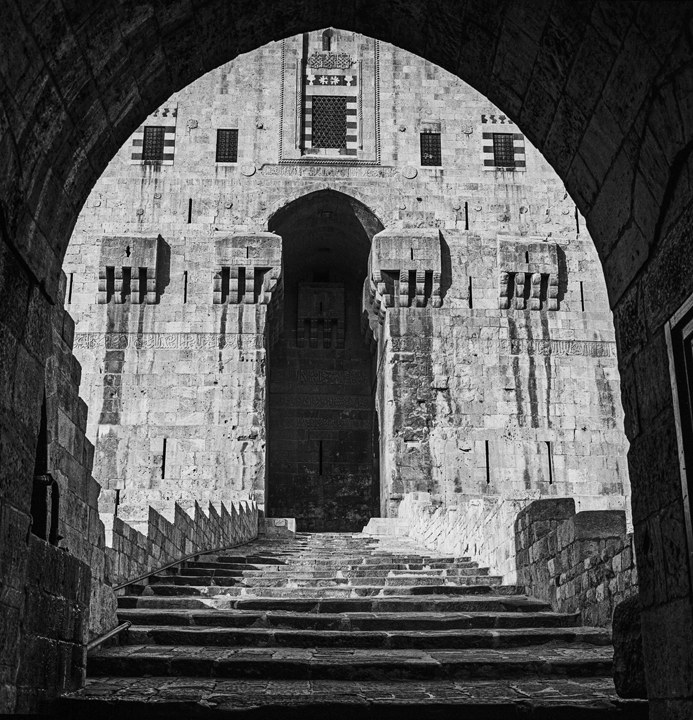
Inner gateway to the Citadel of Aleppo, 2003. From “Legacy in Stone” by Kevin Bubriski, published by powerHouse Books © with courtesy
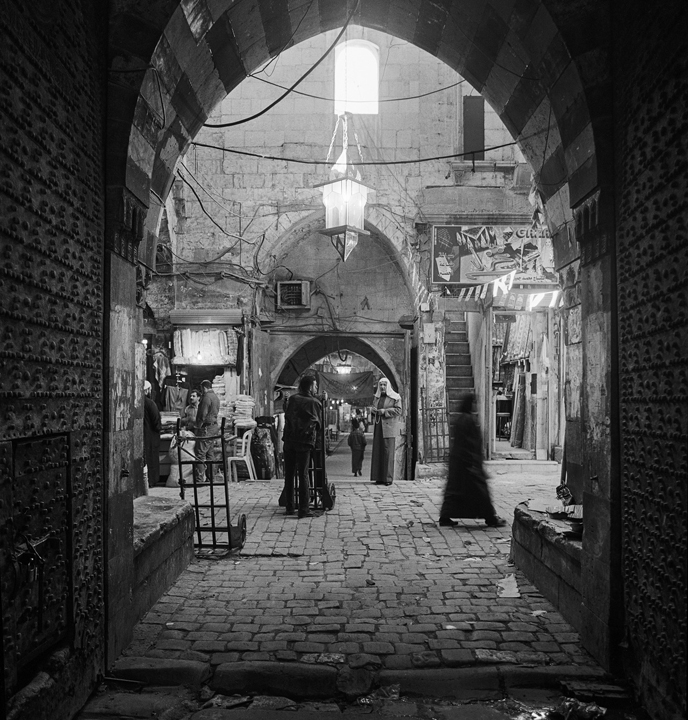
The Suq in Aleppo, 2003. From “Legacy in Stone” by Kevin Bubriski, published by powerHouse Books © with courtesy
Aleppo was busy and thriving, both the modern city and the endless covered labyrinth of stalls and retailers known as the Suq […].The Citadel towered over the city as life went on with uncertainty in the urban sprawl surrounding this broad hilltop fortress.
(Kevin Bubriski, p. 161)
Locals and foreigners would indulge themselves in a variety of goods and delicacies that granted Aleppo its renowned position: pistachios (literally known as “nuts of Aleppo”), the famous “Savon d’Alep”, cotton textile industry, spices, culinary arts and jewelry. The book shows aspects of a, once, everyday life, with snapshots of people walking on the streets, or locals who posed for the camera: young and old, tradesmen, shopkeepers, artisans, craftsmen, Koran students, and veiled women. Besides, the imposing citadel, the souks and bazaars. Altogether, they have not only been part of the city’s long and vibrant history. They have all become part of Aleppo’s calamity.
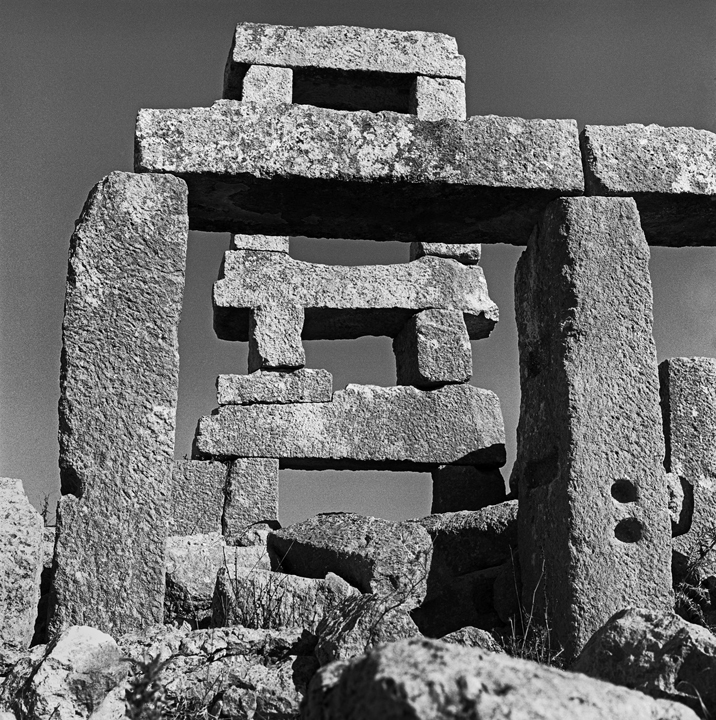
Kharab Shams in the Dead Cities, 2003. From “Legacy in Stone” by Kevin Bubriski, published by powerHouse Books © with courtesy
A short drive north of Aleppo brought me to a landscape of abandoned limestone […]. The rough-edged yet clean-cut stone had sat in these exact positions for almost two millennia, bleached white by the bright Syrian sun.
(Kevin Bubriski, p. 161)
The photographer moved to the Northwest part of the country, where scattered remains of several ancient villages are gathered under the name “Forgotten Cities” – popularly known as “Dead Cities”. Bubriski’s photographs of villages that lack both inhabitants and roofs show a rich interplay of light and shadow on the carved stones. Snapshots can also be just pure magic. Sometimes, photography is all about being present with a camera at the perfect time in the perfect place.
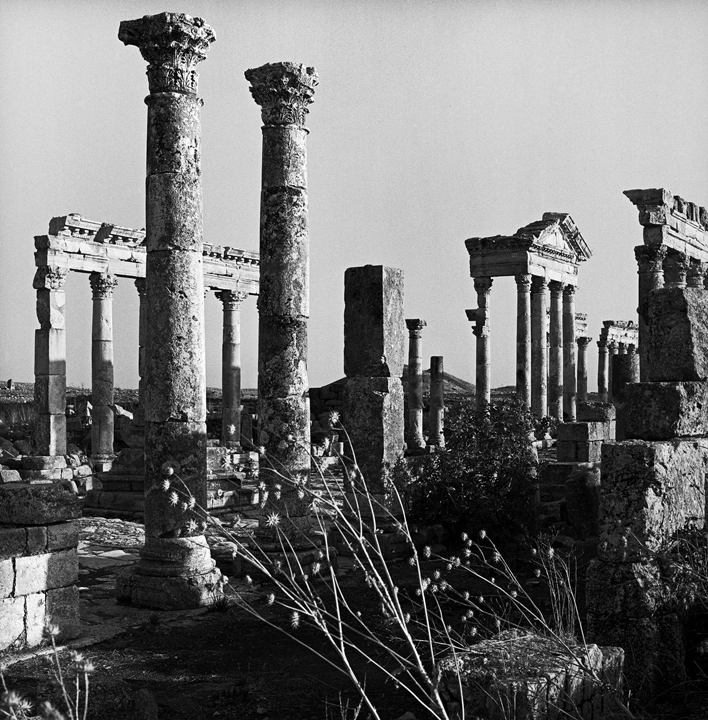
Apamea, 2003. From “Legacy” in Stone by Kevin Bubriski, published by powerHouse Books © with courtesy
The horizon at Apamea was punctuated by the tall, proud, kilometer-long colonnade that demarcated the grand Roman roads of two millennia ago, its variety of Ionic, Doric, and Corinthian columns crowned with austere capitals or richly carved with floral designs.
(Kevin Bubriski, p. 161)
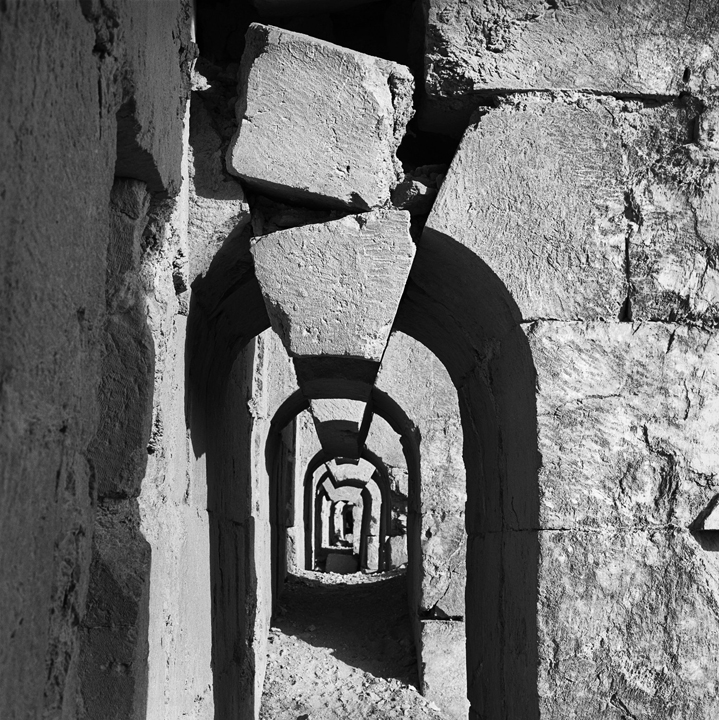
Gallery of the city walls in Resafe, 2003. From “Legacy in Stone” by Kevin Bubriski, published by powerHouse Books © with courtesy
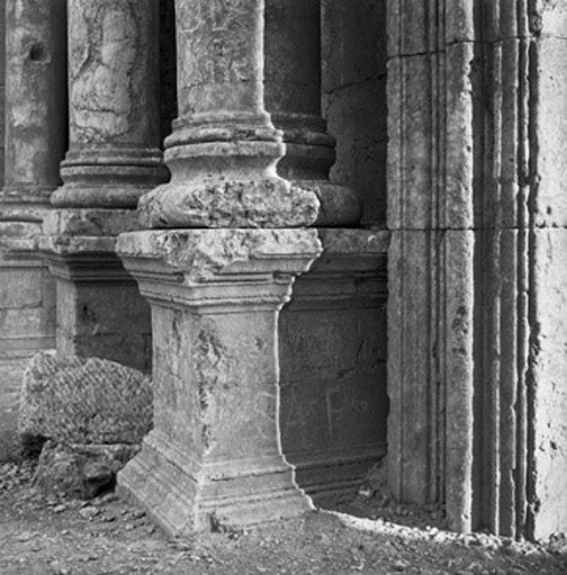
Resafe, North Gate of the city 2003. From “Legacy in Stone” by Kevin Bubriski, published by powerHouse Books © with courtesy
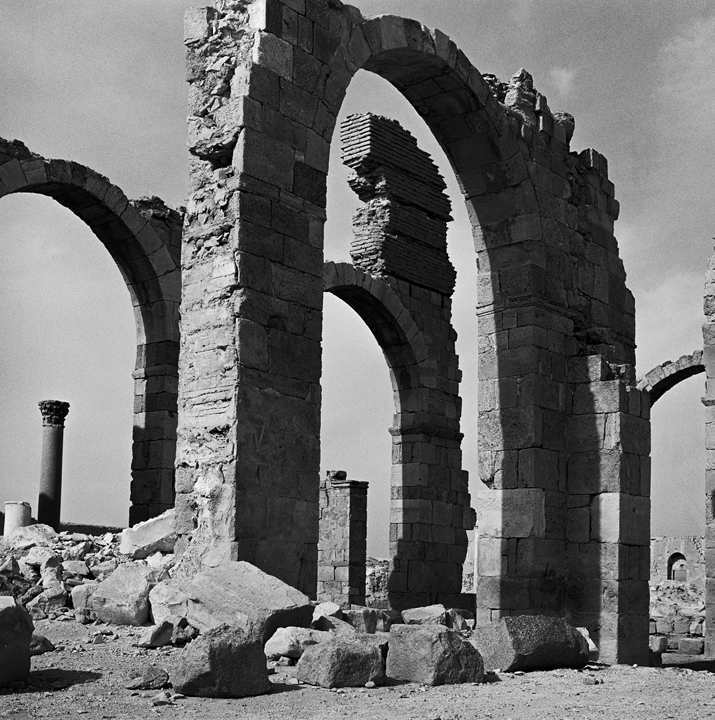
Mosque of the larger enclosure at Quasr Al-Hayr Al-Sharqi, 2003. From “Legacy in Stone” by Kevin Bubriski, published by powerHouse Books © with courtesy
Just before dusk the bright, late afternoon sun shone on the fine stonework of the grand gate of Resafe, slicing the large columns like a knife with a stripe of sunlight that appeared to split them to half their width.
(Kevin Bubriski, p. 162)
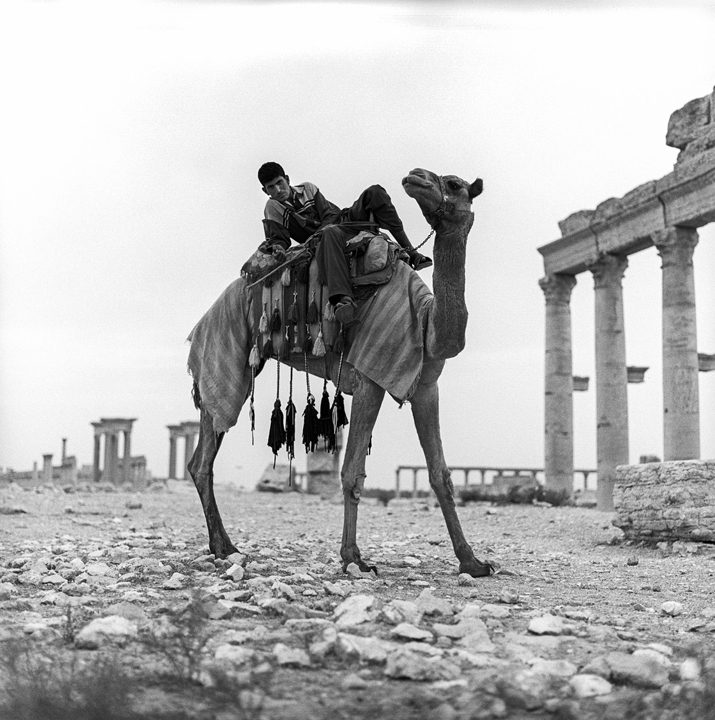
Palmyra, 2003. From “Legacy in Stone” by Kevin Bubriski, published by powerHouse Books © with courtesy
Palmyra – Strongly connected to its Queen Zenobia, grew wealthy from trade caravans that connected East Asia and Europe through luxurious goods, making Palmyra a famous station on the Silk Road.
As the ruins took shape on the ground-glass lens of the Hasselblad film camera, there was an eerie sense of discovery and witness to the haunting beauty and profound history of these ancient monuments.
(Kevin Bubriski, p. 162)
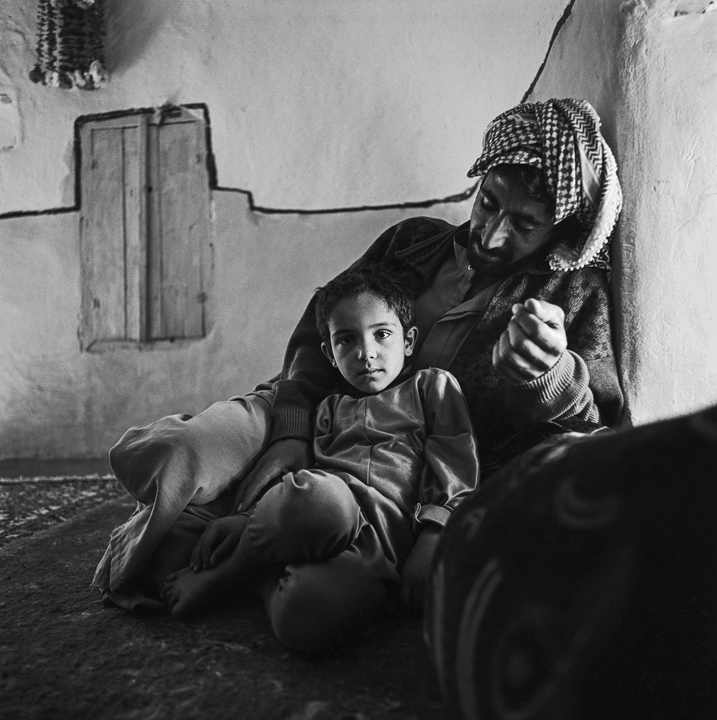
Father and son, North of Aleppo, 2003. From “Legacy in Stone” by Kevin Bubriski, published by powerHouse Books © with courtesy
“Legacy in Stone” will leave different impressions on its broad readership. For someone who never visited Syria before 2011 and never had the chance to encounter its people, seeing Bubriski’s photos is like visiting enchanted places of a fairytale. On the other hand, for someone who knows the country, or is originally from Syria, things are completely different. Today, everything has changed. Death is the eponymous inhabitant of the Dead Cities; the Aleppean Cuisine is exiled; Syrian children are being born and growing up in camps; and terror has wiped Palmyra’s temples off the map. With no end in sight to the suffering of those who remained in Syria, or to the yearning of those who left it, memories of the “good old days” might soothe one reader, or cause another to burst into tears. Looking at those smiling faces of people who posed for Bubriski – now immortalized by choice or by chance in his book, I asked myself what were they thinking back then, and where are they now?
Recalling my cold reaction when my friend first told me about Bubriski’s “Legacy in Stone”, I also recall how my heart started to pound when I first opened the book, and how a smile forced its way onto my face. Many of these photographs are now precious records of a cultural heritage destroyed beyond repair, and of a loss of places and people beyond written words. Otherwise speaking, the book is a “once upon a time” story for the future generations.
Kevin Bubriski (*1954, North Adams, Massachusetts) is a documentary photographer. His photographs are in several permanent collections at the Museum of Modern Art, Metropolitan Museum of Art, San Francisco Museum of Modern Art, and Bibliothèque Nationale de France in Paris. He received Guggenheim, Fulbright, NEA and Robert Gardner Peabody Museum fellowships. In addition to “Legacy in Stone: Syria before War”, Kevin Bubriski’s books include “Portrait of Nepal” (Chronicle Books, 1993), “Pilgrimage: Looking at Ground Zero” (powerHouse, 2002), “Nepal 1975-2011” (Radius Books/Peabody Museum Press, 2014), “Look into my Eyes: Nuevomexicanos por Vida 1981-83” (Museum of New Mexico Press, 2016) and “Our Voices, Our Streets: American Protests 2001-2011” (powerHouse, 2020). Website: https://kevinbubriski.com
Amr Al Azm was director of scientific and conservation laboratories at the Directorate-General for Antiquities and Museums (DGAM) in Syria between 1999 and 2004, and taught at the University of Damascus until 2006. He is a founder and board member on “The Day After Project” (TDA) and coordinator of the Heritage Protection Initiative (TDA-HPI) for protecting cultural heritage in Syria.
Ross Burns served in the Australian Department of Foreign Affairs for over three decades. Between 1984 and 1987 he was the Australian Ambassador to Syria. Ross Buns is the author of “The Monuments of Syria: A Guide”, London, 2009).
Legacy in Stone: Syria Before War
Author(s): Kevin Bubriski, with contributions from Amr Al-Azm, and Ross Burns; Photographs: Kevin Bubriski; powerHouse Books, New York 2019
Zitation
Zeina Elcheikh, Book Review. “Legacy in Stone: Syria before War” by Kevin Bubriski, in: Visual History, 23.11.2020, https://visual-history.de/2020/11/23/book-review-legacy-in-stone-syria-before-war-by-kevin-bubriski/
DOI: https://doi.org/10.14765/zzf.dok-2033
Link zur PDF-Datei
Nutzungsbedingungen für diesen Artikel
Copyright (c) 2020 Clio-online e.V. und Autor*in, alle Rechte vorbehalten. Dieses Werk entstand im Rahmen des Clio-online Projekts „Visual-History“ und darf vervielfältigt und veröffentlicht werden, sofern die Einwilligung der Rechteinhaber*in vorliegt.
Bitte kontaktieren Sie: <bartlitz@zzf-potsdam.de>

